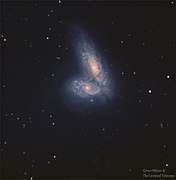NGC 4567 and NGC 4568
NGC 4567 and NGC 4568 (nicknamed the Siamese Twins or the Butterfly Galaxies) are a set of unbarred spiral galaxies about 60 million light-years away[1] in the constellation Virgo. They were both discovered by William Herschel in 1784. They are part of the Virgo Cluster of galaxies. Only one supernova (SN 2004cc) was observed in the Siamese Twins until March 31 2020 when the Zwicky Transient Facility detected the rapidly-rising supernova 2020fqv [2].
| NGC 4567 and NGC 4568 | |
|---|---|
 The Siamese Twins with NGC 4567 (top) and NGC 4568 (bottom) | |
| Observation data (J2000.0 epoch) | |
| Constellation | Virgo |
| Right ascension | 12h 36m 34.3s |
| Declination | +11° 14′ 17″ |
| Distance | 59.4 Mly (18.2 Mpc)[1] |
| Apparent magnitude (V) | +10.9 |
| Absolute magnitude (V) | -13.3 |
| Characteristics | |
| Type | SA(rs)bc / SA(rs)bc |
| Apparent size (V) | 4.6′ × 2.1′ |
| Notable features | colliding galaxies |
| Other designations | |
| NGC 4567/8, UGC 7776, PGC 42064/9, VV 219 | |
These galaxies are in the process of colliding and merging with each other, as studies of their distributions of neutral and molecular hydrogen show, with the highest star-formation activity in the part where they overlap. However, the system is still in an early phase of interaction.[3]
They were named "Siamese Twins" because they appear to be connected.
Gallery
 NGC 4567 and 4568 imaged by the Hubble Space Telescope
NGC 4567 and 4568 imaged by the Hubble Space Telescope RGB image of the colliding galaxies NGC 4567 and NGC 4568. Data from the Liverpool Telescope on La Palma, processed by Göran Nilsson. Exposure: 20 × 90 s
RGB image of the colliding galaxies NGC 4567 and NGC 4568. Data from the Liverpool Telescope on La Palma, processed by Göran Nilsson. Exposure: 20 × 90 s
See also
References
- "Distance Results for NGC 4568". NASA/IPAC Extragalactic Database. Retrieved 2010-05-01.
- SN 2020fqv TNS
- Kaneko, H.; Kuno, N.; Iono, D.; Tosaki, T.; Sawada, T.; Nakanishi, H.; Hirota, A. (2010). "Molecular Gas in the Early Stage of Interacting Galaxies: The NGC 4567/8 Pair". Galaxy Wars: Stellar Populations and Star Formation in Interacting Galaxies. 423: 26. Bibcode:2010ASPC..423...26K.